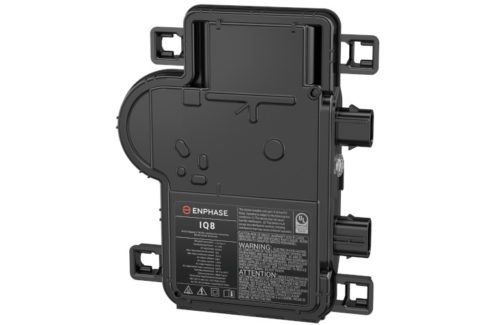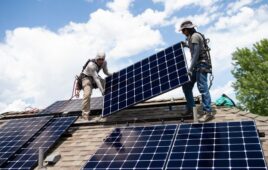 Enphase Energy announced that it has started production shipments of IQ8 microinverters for customers in North America. IQ8 is Enphase’s smartest microinverter yet and fundamentally changes the paradigm for solar technology, which otherwise requires a grid connection to operate. With IQ8, homeowners can now form a microgrid during a power outage using sunlight, providing backup power even without a battery.
Enphase Energy announced that it has started production shipments of IQ8 microinverters for customers in North America. IQ8 is Enphase’s smartest microinverter yet and fundamentally changes the paradigm for solar technology, which otherwise requires a grid connection to operate. With IQ8, homeowners can now form a microgrid during a power outage using sunlight, providing backup power even without a battery.
“We are pleased to deliver our customers the all-in-one Enphase Energy System powered by the software-defined IQ8 solar microinverters,” said Badri Kothandaraman, president and CEO of Enphase Energy. “We began piloting the product in the third quarter of 2021 with select installers and the feedback has been great. Homeowners not only get backup power with sunlight, but also have the flexibility to add more solar or batteries in the future as their needs change.”
The Enphase Energy System with IQ8 comes in four different configurations: the first is Solar Only; the second is Sunlight Backup with no battery and the addition of IQ Load Controller to only support essential loads during an outage; the third is Home Essentials Backup with a small battery; and the fourth is Full Energy Independence with a large battery. While the first configuration is a standard grid-tied system, the remaining configurations are grid-agnostic systems which need the Enphase IQ System Controller 2 (formerly called Enpower smart switch) to island the home during an outage. For homeowners who want a battery, there are no sizing restrictions on pairing an Enphase battery with the solar system. And all configurations can be customized for homeowners with the help of Enphase installer partners.
“The IQ8 Microinverter has changed the way we think about installing home solar energy systems,” said William May, owner and operator of May Electric Solar, an Enphase Energy installer partner based in Florida. “The technology gives us the ability to build a solution that fits our customer needs, with or without a battery, and provides them with reliable, affordable and safer power.”
The IQ8 family includes five types of software-defined microinverters, IQ8, IQ8+, IQ8M, IQ8A, and IQ8H, with peak output AC power of 245VA, 300VA, 330VA, 366VA, and 384VA, respectively. The IQ8H microinverter is Enphase’s most powerful microinverter to date and has a California Energy Commission (CEC) efficiency of 97%. The multiple types of IQ8 enable seamless pairing with a full range of solar modules, up to 540 WDC.
While IQ8 pilot installations began in the third quarter of 2021 with select installer partners, production shipments for Enphase’s broader network of distributor and installer partners in North America started last week.
News item from Enphase Energy








The evolution of solar systems demonstrates how much people have embraced this type of alternative energy. I am very excited, as traditional energy matrices have shown themselves to be increasingly scarce and more expensive due to the lack of rain, not to mention thermoelectric plants, which have weighed even more on the final consumer’s energy tariff.
“While the first configuration is a standard grid-tied system, the remaining configurations are grid-agnostic systems which need the Enphase IQ System Controller 2 (formerly called Enpower smart switch) to island the home during an outage.”
In California right now, it would make sense to go with the Enphase IQ8 and the large battery storage system. Setting up for resiliency during a PSPS event would pay for itself over a couple of years of sporadic use.
“The multiple types of IQ8 enable seamless pairing with a full range of solar modules, up to 540 WDC.”
The pros and cons of system design. I take the mention of a 384VA IQ8 inverter on a 540WDC panel as a form of 1.4 to 1 clipping design. Particularly in high temperature regions basically in the southwestern U.S., summer temperatures and clipping can cause early component and module failure. This could be an Achillies heel of the Ehphase system. When it is a 120 degree F day and it is actually 150 degrees on the roof of a home, these IQ8 modules will take a real beating. Most “house inverters” are installed in the shade or in a garage out of direct sunlight, they last on average 10 years of service in the heat. I’ve found most of these failures are due to the heat sink cooling fan getting “gummed up” and failing to cool the final drivers properly. Many times, this trips out the inverter on temperature and may even destroy a circuit regulator module to take down the whole inverter. I have believed for years now that inverters should use SiC switching transistors and be designed for easy cooling fan, inspection, maintenance and replacement. These inverters should last at least 20 to 25 years in service like the solar PV panels are warranted for. I don’t see this happening when the micro-inverter is installed on the roof under the panels.